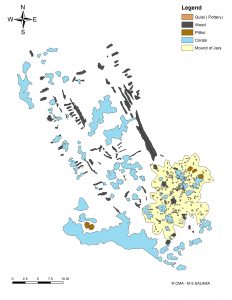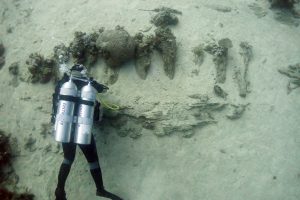The Sadana Island Shipwreck Revisited, CMAUCH - 2018-2020
Emad Khalil
The Sadana Island Shipwreck project aims to carry out an assessment of one of the most important shipwreck sites in Egypt. The Sadana Island Shipwreck is an 18th century Ottoman porcelain carries that was discovered in 1994, c. 40km south of Hurghada along the Red Sea coast of Egypt . The wreck lies at the bottom of the reef at a depth of 30m – 48m. Between 1995 and 1998 the site was partially excavated by the Institute of Nautical Archaeology – Egypt (INA-Egypt). Hundreds of artefacts were excavated from the site, however, thousands were left underwater. They were covered by sand bags hoping to hide them from possible looters. On the other hand, the object that was least studies was the wreck itself. The surveying techniques at that time and the depth of the sites prevented developing accurate plans of the wreck.
Therefore, the current project carried out an evaluation of the site and the condition of the wreck. It also developed a general plan of the site using photogrammetry techniques. Based on that, it was realized that the site is subject to looting by sport divers. Therefore, an in-situ preservation plan has to be developed to be able to protect the sites from further damage. On the other hand, the hull has to be fully excavated, record thoroughly, and then reburied again.
 The Sadana Shipwreck is one of only three ships of the same type that were discovered in the Red Sea. It was used for transporting Chinese porcelains, Arabian earthenware and many other products across the Red Sea to Suez and from there cargo would have been distributed all over the Ottoman Empire.
The Sadana Shipwreck is one of only three ships of the same type that were discovered in the Red Sea. It was used for transporting Chinese porcelains, Arabian earthenware and many other products across the Red Sea to Suez and from there cargo would have been distributed all over the Ottoman Empire.
Summary of Results
– The project confirmed the the condition of the hull is very good and it is mostly preserved beneath the sediments.
– The fact that the site is relatively deep, limits the time that sport divers using single 12L tanks can spend underwater. However, the artefacts which were covered by sandbags in the 90s are now totally exposed and lying on the seabed, which makes them venerable to looting. We were informed by a local boat captain that he has a ceramic jar from the wreck which was given to him by a tourist.
– Having carried out a dive on the site to the depth of 50m, it was realized that the seabed at that depth still contains archaeological remains beneath the soft sediments.
– It became evident that the site required further and more thorough investigation by a larger team, using a bigger boat and excavation equipment. Also the exposed artefacts have to be excavated.

Video of the 2020 fieldwork season on the Sadana Island Shipwreck

